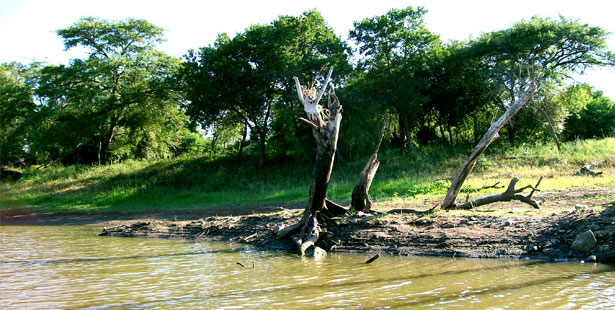
Some times we are faced with conditions that we do not like, conditions we cannot call, but
what will make the difference on how successful we are depends on the choice we eventually make.
When faced with dirty water just after the first summer rains, many anglers that have fished areas with great success pack away their tackle because they are intimidated by the change in water clarity and feel that fishing is just too tough. This is a big mistake as this time can produce some of your best fishing if you approach it with confidence and the right tools.
Bass do not pack up their homes and head for the clear waters on the lake during the summer rains and then only return once the water clears again. Bass adapt to change and so must we - this is the time of year that we need to find those hideouts and make little, subtitle changes that make the difference; keep in mind that you need to find the bait, which is primary in all forms of bassing.
One must remember that the basic premise of fishing is getting the bait in the strike zone - in dirty water this becomes a lot smaller and this is the most important thing to remember. The bass are now in smaller ambush spots (obvious due to the clarity of the water (so the baits we need now are more the vibration, noisy and dark types of lures, such as jigs, Texas rigs for soft plastics; rattling crank baits, spinnerbaits and big, slow working top surface baits.
When I go out jig fishing, I know that I am going to slow down, but don’t think that this means dead slow. With a jig you can power fish as well and you can cover water quickly, especially when you have a pattern and are fishing shallow.
Things to remember when you are out there with a jig: watch the water temperature as this will give you an idea of the type of trailer to use. I like to use a craw-type trailer when the water is 70 degrees and more, but when the water cools I change to a twin tail trailer to slow the fall of the jig. Colour is about what you are comfortable with - remember that the colour should at all time match the hatch, and if the water is very dirty, use the colour you can see the best when it is submerged. I take my jig and reel it up to the tip and then stick the rod tip in the water and count the rod’s eyes until it disappears - this will give me a good idea as to the colour penetration I have. Don’t forget, the bass have far more senses and they are a lot better than ours, especially in water.
My favourite jigs are Picasso, Spider Jig, Fantasy Football Jig, and Shake-E-Football Jig, matched with trailers such as twin-tail grubs, Rage tail chunks and creature baits.
Texas rigged plastic worm fishing is one of the oldest and most effective means of fishing in any conditions and in most situations. Once again we need to understand that in most dirty situations the bass are tight to the structure and your presentation is critical. My personal basic first point of thought is to fish a Texas rig as light as I can get away with. I try not to overweight my Texas rig, and this depends on the wind and the type of lure I am fishing with.
If you fish a straight -tail worm, like a trick worm, it has no legs that could hang on any little twig on its way down to the strike zone, so here you can use a light weight, as you do not want the bait falling at a rate that will startle the bass - you want them to think it is natural, and this way you will get more strikes.
Then you have the flip side of the coin, namely heavy rigs, but I will still use the lightest rig I can get away with. The only time I use a really heavy weighted rig is if I need to punch through heavy matted vegetation to get my bait to the bass; this is the time to use the big guns, up to 1oz at times.
In dirty water conditions I like to use a bait that will get down to the bass and which will produce lots of vibration. I like creature baits, lizards, craws, all basically baits with legs , arms and tails that give off plenty of vibration and that will slow the fall while the legs and arms create a lot of water displacement
I prefer tungsten weights because they are a lot smaller than their lead weight counterparts, and if you add a small weight between the knot and the weight, you have plenty of noise, which is helpful in attracting bass in dingy water. Please remember that when using a tungsten weight, use a glass bead so as not to damage the line. The one from Tru Tungsten is designed not to cause damage to the line.
The hook for this presentation is the one you are most comfortable with - all I can say is that when you are fishing in heavy cover, used a straight worm hook, not the wide gap hooks as they protrude out of the bass’ mouth and tend to hang up when you are trying to get the bass out of dense cover.
Crankbaits also have their place when fishing in dirty water - you need to use a lure that will not dive too deep and hang up on every cast. I like the Spro Little John and Spro Fatcrank for this type of presentation. There are a few reasons for this: it has a good rattle, the little bait is heavy enough to flip and pitch and it dives to a maximum of 6ft, but this you can manage by upsizing the line. Remember that when you fish in heavy cover, don’t fool yourself and underestimate the cunning of a bass - use the heaviest line you can get away with. If you cannot see the line, the chances are good that the bass cannot as well. When fishing a crank bait it is important to remember that your bait must be hitting the structure (the Spro Little John has an almost square bill that prevents it from hanging in the structure). This is what I term “calling the bass”. The banging of the crank against the structure creates noise and this will “call” the bass to that spot. It is also important to remember that you should make repeated casts to the same structure - the first cast is the calling cast and one of the next few will be the catching cast. The bass will tell you what they want - remember to make a mental note of the first fish you catch, as this is the one that will open the door to the pattern for the rest of the day.
Another of my favourite power fishing methods in dirty water is using a spinnerbait. A spinnerbait like the Picasso range has a good thumping blade and is used in the same way, namely to keep the lure bouncing off the structure while making repeated casts. With a spinnerbait I also try to match the hatch and look for a lure that I can see the best in the water. Don’t be afraid to use big blades - sometimes the bigger the better, but this is not for all situations.
During the pre-spawn and spawn there is a another way of ending what you would have thought was going to be a really tough day in the dirty water on the lake, namely the top surface lure. You could ask: “why go and throw a top surface when you can hardly see a foot in the water?” But don’t be fooled. During this time of year, bass are extremely aggressive and will kill anything that comes it its way to feed or to protect the nest. This is the time I bring out another big gun, namely the Spro frog box with a heavy rod and some heavy braided line to get them out of the heavy structure and to be able to set the hooks. This can be one of your most exciting fishing trips and deliver huge bags. My preference when the water is dirty is to use the Spro popping frog - it gives off plenty of noise and can be worked slowly on top of the structure to call the big hens up off the nest.
*Richard Watson is a Protea angler and a Goya pro staffer


 Visit us our
Visit us our